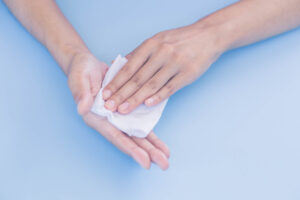December 21, 2022
 If you find yourself worrying about how to get through your next event without anyone noticing your excessively sweaty hands, you may have a medical condition called palmar hyperhidrosis. This condition can take a toll on your quality of life affecting social, academic and professional situations as well as everyday activities.
If you find yourself worrying about how to get through your next event without anyone noticing your excessively sweaty hands, you may have a medical condition called palmar hyperhidrosis. This condition can take a toll on your quality of life affecting social, academic and professional situations as well as everyday activities.
Fortunately, there is a proven solution to resolve palmar hyperhidrosis permanently known as the ETS procedure or Endoscopic Thoracic Sympathectomy.
What is the ETS procedure?
To understand the ETS procedure (Endoscopic Thoracic Sympathectomy), it is helpful to break it down into its basic components. “Endoscopic” refers to a minimally invasive approach that uses a thin, flexible instrument with a camera and light attached. “Thoracic” refers to your chest cavity, where the sympathetic nerve chain is. “Sympathectomy” refers to the surgical dissection of the specific nerves in your body that are responsible for the over activity of sweating palms. By interrupting these nerves at a specific location, the ETS procedure stops the hands from sweating immediately. In many cases, patients also experience improvement in sweating in their feet and axilla (or armpits).
How is ETS performed?
The ETS procedure is performed under general anesthesia, which means you will be asleep. The surgeon makes two small incisions beneath your armpit to access the sympathetic nerve chain. The surgeon then inserts the scope through one incision, using the light and camera to visualize the sympathetic nerve chain. A specialized instrument is then used to interrupt the nerves at a specific location to target the permanent cessation of palmar sweating.
The ETS procedure is performed in an outpatient setting, which means you will be able to go home the same day. Most patients recover at home for approximately one week.
Here are the top five questions to ask when you are deciding about the ETS procedure:
- How is palmar hyperhidrosis affecting my life?
-
- It is important when considering any surgical procedure that you weigh the risks and benefits. In considering the ETS procedure, the condition of palmar hyperhidrosis must have a significant negative affect on your life. Often patients report excessive sweating in the hands makes performing even the most basic tasks very difficult. Social engagements, academic activities and professional tasks are often negatively impacted by this condition.
- Should I try other treatment options first?
-
- Before undergoing a surgical procedure, you may consider other treatment options for hyperhidrosis first. Some patients have seen reduction in palmar hyperhidrosis with treatments such as prescription strength antiperspirants and iontophoresis (a procedure involving targeted electrical currents). While these other options may provide some relief in a percentage of patients, it is unfortunately only temporary. The ETS procedure is the only treatment proven to effectively cure palmar hyperhidrosis – leading to a permanent solution in 99% of cases.
- Am I a candidate for the ETS procedure?
-
- If palmar hyperhidrosis is your primary area of concern, then you may be a candidate for the ETS procedure. There are some pre-existing medical conditions that may limit your candidacy, however that only accounts for a very small percentage. It is important to share your complete medical history with your physician during your consultation.
- What are the risks?
-
- Like any surgical procedure, the ETS procedure includes risks such as bleeding and infection, however the incidence is minimal. In some patients, a condition called “compensatory hyperhidrosis” can occur after the ETS, which means that you may experience sweating in a different part of the body. In these cases, the sweating often occurs on the back or legs, rather than extremities and is less intense.
- What are the benefits?
- The benefit of the ETS procedure is permanent cessation of palmar sweating with a success rate of 99 percent. Most patients are back to their normal routine in just a week after their procedure. Patients experience a renewed confidence with warm, dry hands.
If you suspect you have hyperhidrosis, don’t suffer in silence. There are many options for hyperhidrosis relief including the ETS procedure. The experts at the Hyperhidrosis Center at Thoracic Group can work with you to develop a treatment plan to meet your goals. Call us today to learn more at (732) 398-5099.
 If you find yourself worrying about how to get through your next event without anyone noticing your excessively sweaty hands, you may have a medical condition called palmar hyperhidrosis. This condition can take a toll on your quality of life affecting social, academic and professional situations as well as everyday activities.
If you find yourself worrying about how to get through your next event without anyone noticing your excessively sweaty hands, you may have a medical condition called palmar hyperhidrosis. This condition can take a toll on your quality of life affecting social, academic and professional situations as well as everyday activities.